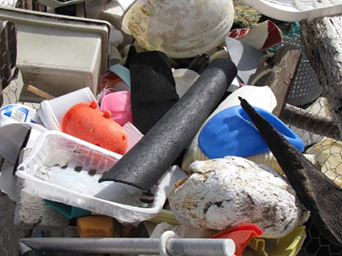The Making of Cosmo the Tufted Puffin
If you've ever been to the town of Bandon you've probably seen the 'Sea Trash' sculptures from our friends, and WRCA grantee, Washed Ashore. We continue to be impressed by the great work they're doing to help clean up Bandon's beaches and educate the world on the dangers of marine debris.
In celebration of Earth Day, we are excited to share the story of their newest Tufted Puffin, Cosmo. So without further ado, enjoy the 'Making of Cosmo the Tufted Puffin' by Angela Haseltine Pozzi & Washed Ashore: Art to Save the Sea!
 Every piece of plastic on Cosmo was found on the beaches near Bandon, Oregon. Nothing is ever colored. Stainless steel wire, screws, and frame make it long lasting.
Every piece of plastic on Cosmo was found on the beaches near Bandon, Oregon. Nothing is ever colored. Stainless steel wire, screws, and frame make it long lasting.



Soon he will have a cement base which will imitate the shape of a large rock.


Details of the Wing Feathers show hangers, pipes, flip flops, handles, miscellaneous plastics, and more.
Cosmo’s life began at the beach.



Buoys from Korean Aquaculture are gathered off the beach to create his feathers. Large black plastic garbage cans and buckets were used as base plastics. These were wired onto the steel frame and became the base for the volunteer-made panels. Tires are difficult to remove from beaches with high cliffs, and State Park partners often help out. These are a challenge to cut, but make excellent parts of wings.






Everything is sorted by color, size, and shape. Orange is pulled for Cosmo’s feet. Black and white flipflops are an important part of sculpting the head and feathers. Long and thin black plastic is pulled for the feathers. Pipes become an important supply for our volunteers to use as they string and stitch feather panels. The debris yard hosts a wide array of possibilities. A mysterious large orange plastic piece is cut for the base of the feet and part of the beak of the Puffin.



Our free community workshops created much of the work on Cosmo’s back and belly. “Trash-kabobs” are often made by young children who come with their families to our workshop. These were used on Cosmos fluffy belly.



While the volunteers worked on panels and kabobs, Angela worked on the head, neck, feet, and wings. The stainless steel frame of the head was first covered with base plastics then covered carefully with the correct colors for puffin’s markings. His tufts are made of cut rubber buoys. His top crown is made of sliced golf balls (help us protect ocean life by not hitting your golf balls into the ocean on our ocean holes). Angela added the finishing touches with individually chosen and cut feather plastics.
What's next?
















